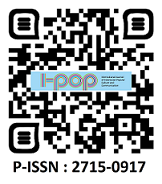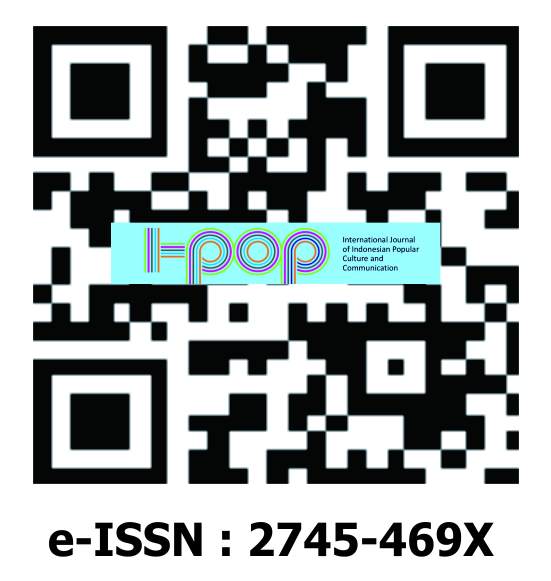Female Masculinity Representation in Still Sick Yuri Manga
Indonesian Perspective
DOI:
https://doi.org/10.36782/i-pop.v4i1.130Keywords:
Female masculinity, manga and anime, representation, semiology, yuri genreAbstract
Indonesia has an enormous manga audience and fans. One of the known genres is Yuri, a lesbian romance story. As a country with many Muslims who practice some Islamic customs, it is not surprising that this genre is often seen as controversial since it conflicts with moral teachings and is labeled as an LGBTQ+ normalization space. However, to not see the genre objectively is also a waste since it represents the actual life of women, especially lesbians, in a heteronormative society that glorifies androcentric capitalistic patriarchal ideology—something we also usually see in Indonesia. Therefore, the Yuri genre is a counter-narrative to Japanese and Indonesian society. Using Barthes’ semiology with Janet Chafetz’s seven traits of masculinity, we analyzed the representation of female masculinity and lesbian traits in the Still Sick manga to decode the representation of a lesbian’s female masculinity in Yuri manga. This article offers a new perspective on this discriminated genre. It shows that entertainment media bears criticism against its society while helping the public, especially domestic hobbyists, understand Yuri manga and its female masculinity more. Five points can be discussed in this article: 1) the shakaijin Yuri theme reconstructs the girls’ love genre and masculinity in manga and anime, 2) the negotiated power relation between lesbian households, 3) women’s hybrid ikigai acts as a critique against the masculine counterpart, and 4) critic against the heteronormative-homophobic society through the representation of lesbian life in Japan. The comparison between Japanese and Indonesian popular culture is also discussed to understand the context.
Downloads
References
Ajidarma, S. G. (2021). Ngobrolin Komik. Pabrik Tulisan.
Akashi. (2021). Untitled [Postcard Illustration]. Twitter. Japan.https://mobile.twitter.com/eeo_store/status/1446374681351647233?fbclid=IwAR2YDCCRF0NDjEqBBpDYCSy5WqyfD78DY6WJw5a03jBJ
Akashi. (2020). Still Sick Vol. 3. Twitter. Japan. https://mobile.twitter.com/eeo_store/status/1446374681351647233?fbclid=IwAR2YDCCRF0NDjEqBBpDYCSy5WqyfD78DY6WJw5a03jBJQhsYs5L54fV_tX0.
Akashi. (2019). Still Sick Chapter 11. Twitter. Japan. https://mobile.twitter.com/eeo_store/status/1446374681351647233?fbclid=IwAR2YDCCRF0NDjEqBBpDYCSy5WqyfD78DY6WJw5a03jBJQhsYs5L54fV_tX0.
Akashi. (2018). Still Sick Vol. 1. Twitter. Japan. https://mobile.twitter.com/eeo_store/status/1446374681351647233?fbclid=IwAR2YDCCRF0NDjEqBBpDYCSy5WqyfD78DY6WJw5a03jBJQhsYs5L54fV_tX0.
Amaliananda, A., Rahayu, L. P., Hidayati, R. N., Savira, N. A. (2017). Gender-Role Portrayals in Indonesian Movies. Proceedings 1(2017), 1-6. http://proceedings.ui.ac.id/index.php/uipssh/article/viewFile/65/109.
Baumann, N. (2021, Auguts 18). Beyond the School Cathedral: How Yuri Grew Up. Anime News Network. https://www.animenewsnetwork.com/feature/2021-08-18/beyond-the-school-cathedral-how-yuri-grew-up/.175613.
Brasor, P., Tsubuku, M. (2019, March 5). Japan's Tax Laws Get in the Way of More Women Working Full Time. Japan Times.
Bolso, A. (2002). Power in the Erotic: Feminism and Lesbian Practice. (ISBN-nummer 82-471-5107-3 ) [Doctorate thesis, NTNU Trodheim]. NTNU Trondheim. https://ntnuopen.ntnu.no/ntnu-xmlui/handle/11250/264969.
Cho, M., Impett, E. A., Campos, B., Chen, S., Keltner, D. (2020). Socioeconomic Inequality Undermines Relationship Quality in Romantic Relationships. Journal of Social and Personal Relationships, 37(5), 1722–1742. https://doi.org/10.1177/0265407520907969.
Crees, N. Grousset-Rees, H., Richards, V., Davies, K., McLoughlin, E. (2022). Exploring UK Media's Influences on Public Perception of LGBTQIA+ Representations at Pride Festivals. Journal of Policy Research in Tourism Leisure and Events, 1-21. http://dx.doi.org/10.1080/19407963.2022.2045301.
Dahlberg-Dodd. (2018). Talking like a Shounen Hero: Masculinity in Post-Bubble Era Japan Through the Lens of Boku and Ore, Buckeye East Asian Linguistics, 31, 1-12. https://kb.osu.edu/handle/1811/86767.
Dozier, R. (2017). Female Masculinity at Work: Managing Stigma on the Job. Psychology of Women Quarterly, 41(2), 197-209. https://doi.org/10.1177/0361684316682956.
Ellis-Rees, A. (2016, October 17). Land of The Rising Sun: The Dichotomy of Japanese Masculinity. Varsity. https://www.varsity.co.uk/culture/10916.
Erwantoro, H. (2011). Sensor Film di Indonesia dan Permasalahnnya dalam Perspektif Sejarah (1945-2009). Patanjala, 3(2), 365-383.
Fiske, J. (2016). Introduction to Communication Studies. First Edition. Methuen & Co. Ltd. Terjemahan Irfan Ibrahim. Pengantar Ilmu Komunikasi. Cetakan Pertama. Buku Litera.
Galbraith, P. W. (2014). The Moe Manifesto: An Insider's Look at the Worlds of Manga, Anime, and Gaming. Tuttle Publishing.
Gardner, J. (2012). Projections: Comics and the History of Twenty-First Century Storytelling. Standford University Press.
Goldstein-Gidoni. (2019). The Japanese Corporate Family: The Marital Gender Contract Facing New Challenges, Journal of Family Issues, 1-30. https://doi.org/10.1177/0192513X19830147.
Hisada, M. (2007). They've Got Their Happy Faces On. In McLelland, M., Suganuma, K., Welker (Eds.), Queer Voices From Japan: First-Person Narratives from Japan's Sexual Minorities (pp. 181-194). Lexington Books.
Iida, A. (2018). Gender Inequality in Japan: The Status of Women, and Their Promotion in the Workplace. Cojourn, 3(3), 43-52. https://doi.org/10.14267/cojourn.2018v3n3a5.
Izumo, M., Tsuzura, Y., Hara, M., Ochiya, K. (2007). Japan's Lesbian Movement. Dalam McLelland, M., Suganuma, K., Welker, J. (Eds.), Queer Voices From Japan: First-Person Narratives from Japan's Sexual Minorities (pp. 195-223). Lexington Books.
King, S., Ren, Y., Idemaru, K., Sturtzsreetharan, C. (2021). Sounding Like a Father: The Influence of Regional Dialect on Perceptions of Masculinity and Fatherhood. Language in Society, 1-24. http://dx.doi.org/10.1017/S0047404520000925.
Kobayashi, N. (2018, September 10). Employers Must Help Cut Japan's Suicide Rate. Nikkei Asia. https://asia.nikkei.com/Opinion/Employers-must-help-cut-Japan-s-suicide-rate.
Kusuma, A. (2012). Perempuan dan Budaya Patriarkhi dalam Film “Berbagi Suami” Karya Sutradara Nia Dinata. E Journal UPN Veteran Jatim, 1-19. http://ejournal.upnjatim.ac.id/index.php/ilkom/article/view/321.
Lamarre, T. (2009). The Anime Machine: A Media Theory of Animation. University of Minnesota Press.
Lies, E. (2013, July 22). Why Japan is Counting on Anime, Manga to Boost Economy. CBN. https://news.abs-cbn.com/business/07/22/13/why-japan-counting-anime-manga-boost-economy/.
Lilja, M. & Wasshede, C. (2016). The Performative Force of Cultural Products: Subject Positions and Desires Emerging from Engagement with the Manga Boys' Love and Yaoi. Culture Unbound, 8(3), 284-305.
Lubis, M. A. (2017). Using Comics as A Teaching Material in Building Character of Elementary School Students. Journal of Madrasah Ibtidaiyah Education, 1(2), 246-258. https://doi.org/10.32934/jmie.v1i2.44.
Ma, G., Yang, C., Qin, Z., Guo, M. (2021). Hegemonic Masculinity in East Asia: China, South Korea, and Japan. Advances in Social Science, Education, and Humanities Research, volume 625, 2405-2410. https://www.atlantis-press.com/article/125967298.pdf.
MacWilliams, M. W. (2008). Introduction to Japanese Visual Culture: Explorations in the World of Manga and Anime. In MacWilliams, M. W (Ed.), Japanese Visual Culture: Explorations in the World of Manga and Anime (pp. 3-25). East Gate.
Marasabessy, N. (2021). Patriarchy and Women's Emancipation in Indonesian Film: Marlina the Murderer in Four Acts and Perempuan Berkalung Sorban. Jurnal Dakwah dan Sosial, 4(02), 143-168. https://doi.org/10.37680/muharrik.v4i02.821.
Maser, V. (2013). Beautiful and Innocent: Female Same-Sex Intimacy in the Japanese Yuri Genre. [Thesis, Universität Trier,]. Universität Trier. https://ubt.opus.hbz-nrw.de/opus45-ubtr/frontdoor/deliver/index/docId/695/file/Maser_Beautiful_and_Innocent.pdf.
Mathews, G. (2002). Can 'A Real Man' Live for His Family?. In Roberson, J. & Suzuki, N. (Eds.), Men and Masculinities in Contemporary Japan: Dislocating the Salaryman Doxa (pp. 109-125). Routledge Curzon.
McLelland, M. J. (2000). Male Homosexuality in Modern Japan: Cultural Myths and Social Realities (First Edition). Curzon Press.
McLelland, M. J., Suganuma, K., Welker, J. (2007). Introduction: Re(Claiming) Japan's Queer Past. In McLelland, M., Suganuma, K., Welker, J. (Eds.), Queer Voices From Japan: First-Person Narratives from Japan's Sexual Minorities (pp. 1-29). Lexington Books.
Monden, M. (2014). Layers of the Ethereal: A Cultural Investigation of Beauty, Girlhood in Japanese Shoujo Manga. Fashion Theory the Journal of Dress Body & Culture, 18(3), 251-296. https://doi.org/10.2752/175174114X13938552557808.
Mitsuhashi, Y. (2017, August 8). Ikigai: a Japanese Concept to Improve Work and Life. BBC. https://www.bbc.com/worklife/article/20170807-ikigai-a-japanese-concept-to-improve-work-and-life.
Nabilla, M. & Novianti, N. (2019). Masculinity of a Major Female Character in Joel Coen's The Big Lebowski. Passage 2019, 7(3), 101-113. https://ejournal.upi.edu/index.php/psg/article/view/21287.
Nakamura, K. & Matsuo, H. (2002). Female Masculinity and Fantasy Spaces. In Roberson, J. & Suzuki, N. (Eds.), Men and Masculinities in Contemporary Japan: Dislocating the Salaryman Doxa (pp. 59-76). Routledge Curzon.
Nemeth, B. (2014). Masculinities in Japan: Discovering the Shifting Gender Boundaries of Contemporary Japan. OLOMOUC. https://theses.cz/id/w3ov0n/Diplomova_Praca_Barbara_Nemeth.pdf.
Nicolov, A. (2016, December 2). How Manga is Guiding Japan's Youth on LGBT Issues. Dazed. https://www.dazeddigital.com/artsandculture/article/32647/1/how-manga-is-guiding-japan-s-youth-on-lgbt-issues.
Okuyama, Y. (2015). Japanese Mythology in Film: Japanese Mythology in Film a Semiotic Approach to Reading Japanese Film and Anime. Lexington Books. Lanham. The US.
Patton, M. Q. (2015). Qualitative Research & Evaluation Methods. Fourth Edition. SAGE Publication.
Phekoo, A. (2018, June 1). From Tender to Heartbreaking: Yuri Manga that Deals with Relatable LGBT Issues. Women Write About Comics. https://womenwriteaboutcomics.com/2018/06/from-tender-to-heartbreaking-yuri-manga-that-deals-with-relatable-lgbt-issues/.
Planty, B. (2020, June 25). The Beauty of Takako Shimura's Queer Slice-of-Life. Crunchyrolll News. https://www.crunchyroll.com/anime-feature/2020/06/25-1/the-beauty-of-takako-shimuras-queer-slice-of-life.
Purnamasari, I. A. P. A., Pinka, R. A., Hardianto. (2021). Analisis Perkembangan Kepribadian Tokoh Shouya Ishida dalam Anime Koe no Katachi. JPBJ, 7(2), 146-157. http://dx.doi.org/10.23887/jpbj.v7i2.34842.
Reisel, M. (2018). From "Galapagos Syndrome" to Globalization. International Journal of Business Anthropology, 7(2), 1-21.
Saidi, A. I. & Puspitasari, D. G. (2020). Problematika Film Alih Media: Dari Transformasi hingga Kontroversi. Jurnal Panggung,, 30 (2), 183-203. http://dx.doi.org/10.26742/panggung.v30i2.1203.
Santosa, H. P. (2013). Calon Legislatif Lokal dalam Iklan-iklan Politik (Kajian Semiotika terhadap Iklan-iklan Politk Calon Legislatif Lokal di Media Massa Cetak Lokal Jawa Tengah). Interaksi: Jurnal Ilmu Komunikasi, 2(2), 1-12. Https://doi.org/10.14710/interaksi.2.2.104-116.
Sari, D. P., Effendy, C., Wartiningsih, A. (2019). Maskulinitas Tokoh Utama dalam Kumpulan Cerita Pendek Nadira Karya Leila S. Chudori. Jurnal Pendidikan dan Pembelajaran Khatulistiwa, 8(2), 1-11. https://jurnal.untan.ac.id/index.php/jpdpb/article/view/31399.
Sawabe, H. (2007). Wakakusa no Kai: The First Fifteen Years of Japan's Original Lesbian Organization. In McLelland, M., Suganuma, K., Welker, J. (Eds.), Queer Voices From Japan: First-Person Narratives from Japan's Sexual Minorities (167-180). Lexington Books.
Seko, Y. & Kikuchi, M. (2021). Self-Injury in Japanese Manga: A Content Analysis. Journal of Medical Humanities 42, 355-369 (2021). https://doi.org/10.1007/s10912-019-09602-9.
Shamoon, D. M. (2012). Passionate Friendship. University of Hawaii.
Shamoon, D. M. (2008). Situating the Shoujo in Shoujo Manga: Teenage Girls, Romance Comics, and Contemporary Japanese Culture. In MacWilliams, M. W. (Ed.) Japanese Visual Culture: Explorations in the World of Manga and Anime (pp. 137-154). East Gate.
Sidjabat, Y. R., Yulianto, V. I., Koapaha, R. B. (2018). Politik Identitas dalam Perspektif Poskolonial: Studi Kasus Hip Hop Dangdut Grup NDX AKA. Calls, 4(2), 77-88. http://e-journals.unmul.ac.id/index.php/CALLS/article/view/1693/1283.
Siregar, J. P. (2018). The Ideological Meanings of Heritage: The Conflicting Symbols in Yogyakarta, Indonesia. Journal of Architecture and Built Environment, 45(2), 121-132. https://dimensi.petra.ac.id/index.php/ars/article/view/21411/19557.
Soto-Sanfiel, M. T., Villa, R. M. P. & Ibiti, A. (2014). The Role of Sexual Orientation and Gender in the Appreciation of Lesbian Narratives. The French Journal of Media Studies, 5(2014), 1-28. http://inmedia.revues.org/775.
Sugawa-Shimada, A. (2019). Shoujo in Anime: Beyond the Object of Men's Desire. In Berndt, J., Nagaike, K., Ogi, F (Eds.), Shoujo Across Media: Exploring "Girl" Practices in Contemporary Japan (181-206). Palgrave MacMillan.
Unser-Schutz, G. (2015). What Text Can Tell Us about Male and Female Characters in Shoujo Manga? East Asian Journals of Popular Culture, 1(1), 133-153. https://doi.org/10.1386/eapc.1.1.133_1.
Villa, L. F. (2019). Classic Patriarchal Values and Their Effects on Working Japanese Women. Revista Mundo Asia Pacifico, 8(14), 60-75. https://doi.org/10.17230/map.v8.i14.04.
Vitriani, N., Budiana, I. M. (2018). Pola Asuh terhadap Anak Tunarungu dalam Manga Koe no Katachi Karya Ooima Yoshitoki. Jurnal Humanis, 22(2), 488-495. https://doi.org/10.24843/JH.2018.v22.i02.p30.
Wang, Z., Romat, H., Chevalier, F., Riche, N. H., Murray-Rust, D., Bach, B. (2022). Interactive Data Comics. IEEE Transactions on Visualization and Computer Graphics, 28(1): 944-954. http://dx.doi.org/10.1109/TVCG.2021.3114849.
Yamanashi, M. (2012). A History of The Takarazuka Revue since 1914. Koninklijke Brill NV & Global Oriental. Leiden.
Yasuo, Y. (2013, December 20). The Evolution of the Japanese Anime Industry. Nippon.com. https://www.nippon.com/en/features/h00043/.
Yokota, A. (2018, November 21). Gov't Ponders Unmarried Single Parents' Tax Deduction; Criticism of Income Limit Remains. https://mainichi.jp/english/articles/20181121/p2a/00m/0na/015000c.
Yu, S. (2015). Japanese Anime and Woman's Gender-Role Changing. [Master’s Thesis, University of Jyväskylä]. University of Jyväskylä. https://jyx.jyu.fi/handle/123456789/45695.
Yulius, H. (2021). C*bul: Perbincangan Serius tentang Seksualitas Kontemporer (Edisi Diperluas). CV. Marjin Kiri.









